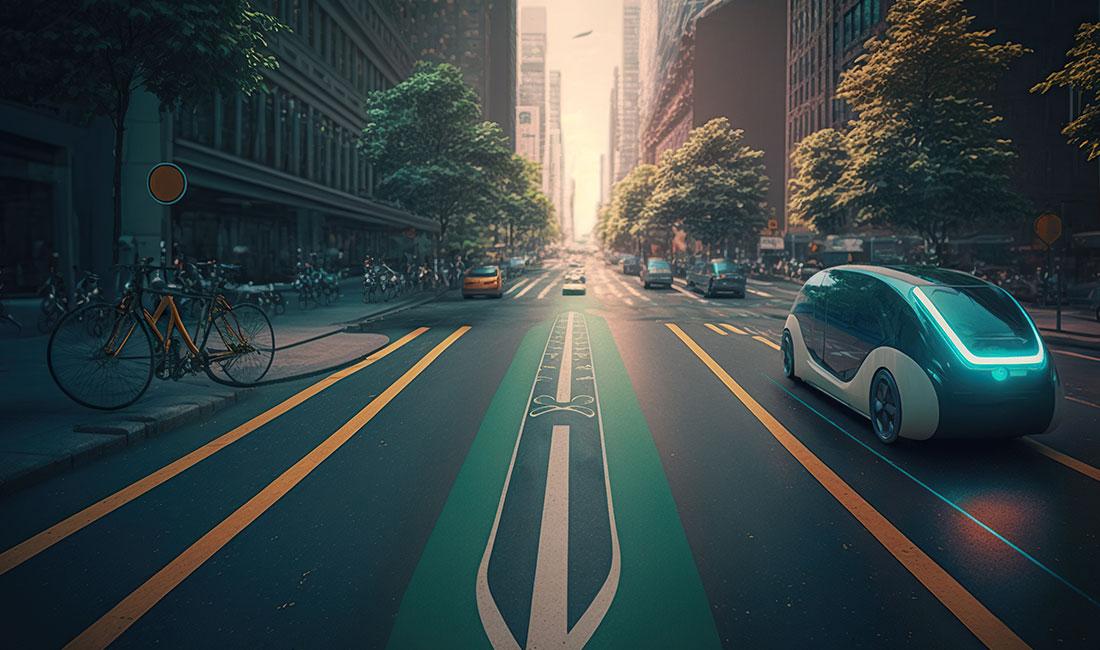Attention
This website is best viewed in portrait mode.
Publication Name: Mobilitymakers
Date: January 01, 2024
Enhancing Passenger Experience through Eco-Conscious Travel

In the rapidly evolving world of automotive technology, passenger experience has emerged as a key focal point for OEMs and Tier 1 suppliers. Today, automakers are striving towards creating an immersive and comfortable environment for passengers. From Advanced Driver assistance systems (ADAS) to incorporating safety technologies, introducing cutting-edge infotainment systems, and advanced connectivity features enabled by 5G, Passenger experience has undergone a profound transformation.
How to create trust and empathy, and how to create relevant personalization are the questions that Automotive leaders are grappling with today.
Changing Perceptions
A noticeable shift in perception can be observed regarding the view of car ownership while comparing Generation X & Y (commonly known as Millennials) vis-a-vis Gen Z. Car ownership has traditionally been seen as a symbol of freedom and status for Gen X while Gen Y focuses more on specifications like mileage, economy, performance, etc. On the contrary, Gen Z has increasingly embraced a mindset that prioritizes experiences and personalization and is increasingly comfortable with the concept of shared and on-demand mobility.
Gen Z being heavily digitally augmented, the focus is more on accessing convenient and immersive transportation experiences. It might not matter to them how much traffic is there on the road as long as you give them a cocoon with music, a movie playing, or the ability to work while they are traveling.
Automotive experiences are beginning to go beyond “in the vehicle” to “near the vehicle”, “out of the vehicle” and “away from the vehicle”.
Being able to use cameras and facial scans to open the door and access the vehicle, identifying the nature of the trip based on passenger personas and providing personalized music/entertainment suggestions, car-seat profile setting, or being able to look at a video of the car parked in a parking lot are some examples.
Voice UX and AI are bound to change the game in terms of customization and convenience. Imagine rattling off commands to the infotainment to get maps guidance, change entertainment modes, or even get alerts and alarms in a conversational way instead of the conventional beeps and tones.
Automakers therefore must now adapt and offer diverse, on-demand mobility options that cater to the preferences of these forward-thinking generations.
Paving the Way for Sustainable Mobility
Consumers today are becoming environment conscious as they seek options (Electric Vehicles/Shared Mobility) that align with their sustainability values. The desire to minimize their carbon footprint has led them to embrace a more holistic approach towards mobility, where the focus is not just on convenience but on environmental impact as well.
Digital Design plays a key role in being able to “Simulate and Stimulate” sustainability.
Simulation involves the use of advanced technologies to provide passengers with immersive experiences and highlights the benefits of Sustainable mobility. For example, automakers can develop interactive simulations that showcase the advantages of green mobility, such as reduced emissions, quieter rides, and enhanced energy efficiency.
Stimulation, on the other hand, refers to the active engagement and encouragement of passengers to adopt sustainable behaviors during their journey. By combining both, the passenger experience can be elevated to new heights with informed decision-making through data analytics.
Here are a few emerging megatrends that are revolutionizing sustainable mobility.
- Electrification
When electrification and digital passenger experience converge, the potential for sustainable mobility is maximized. Electric Vehicles can leverage digital connectivity to optimize charging strategies, allowing users to find and reserve charging stations, monitor energy consumption, and even participate in smart grid initiatives. Digitalization lends itself beautifully to the concept of sustainable driving by the vehicle being able to “Simulate and Stimulate”.
The vehicle can prompt you before a journey about the most sustainable route, fuel saved, or a comparison of carbon footprint for an EV, Petrol, and diesel car. That would stimulate the driver to take a sustainable option and feel good about it.
- Shared Mobility
Services such as ridesharing, carpooling, and car-sharing platforms help optimize vehicle occupancy rates and reduce the number of vehicles on the road. This also helps in alleviating parking space requirements majorly in metro cities. Shared mobility might take you longer to reach your destination, but the simulation of saved fuel, lesser carbon footprint, and a better planet will definitely be a more fulfilling experience.
- Connectivity
The deployment of 5G is expected to have a transformative impact on sustainable mobility by enhancing connectivity and enabling various advancements in passenger experience. Real-time information, seamless intermodal connectivity, shared mobility platforms, intelligent transportation systems, personalized experiences, and data-driven decision-making should converge to a sustainable future. - Autonomous Driving
Autonomous vehicles can optimize driving patterns, reduce congestion, and improve traffic flow through advanced algorithms and real-time data analytics. The car can decide the most sustainable route from point A to point B. When integrated with shared mobility, technology will enable the efficient use of vehicles. Autonomy can help in optimizing vehicles to drive in an energy-efficient manner, considering factors like speed, acceleration, parking spaces, and reduced risk of accidents on the road.
Conclusion
By placing consumers at the center of mobility efforts, enhanced passenger experience will contribute towards a greener, more efficient, and inclusive transportation system that will benefit not just the community but the environment as well.
Balancing the twin goals of reducing our carbon footprint and ensuring an enjoyable experience for passengers is the key to transforming the way we travel and the next big opportunity for automakers.
Author: Utkarsh Biradar, Chief Designer, Industrial Design and Visualisation, Tata Elxsi




